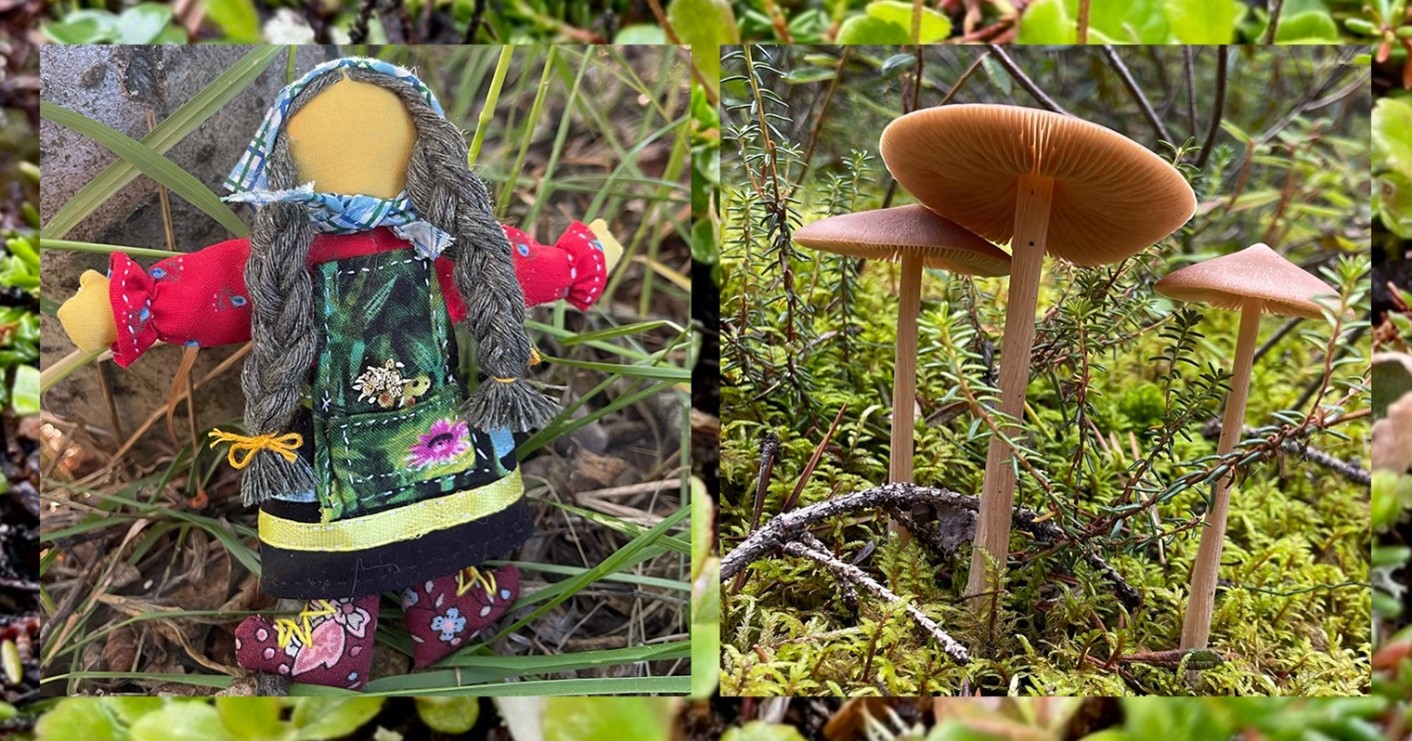Materiality, Tactility, and Artmaking: An Exploration of Diasporic Trauma through Creative Pedagogy
Main Article Content
Abstract
This paper explores the role of artmaking and tactile materials in learning and overcoming “stuckness” (Hage, 2009; Cangia, 2021), a state of discomfort caused by mobility constraints through an autobiographical approach. I explore how the tactile material artmaking processes can generate educational sites, and serve as a pathway to process trauma. The findings of this paper can empower learners to harness the therapeutic potential of artmaking, fostering resilience and growth through the creative process.
Downloads
Article Details

This work is licensed under a Creative Commons Attribution-ShareAlike 4.0 International License.
The copyright notice is CC BY SA.
This license lets others remix, tweak, and build upon your work even for commercial purposes, as long as they credit you and license their new creations under the identical terms. All new works based on yours will carry the same license. Thus any derivatives will also allow commercial use. For example, if someone translates your article into French, the French version of the article will also have to be shared under a CC BY SA license.
References
Alexander, B. C. (1991). Victor turner revisited: Ritual as social change. Scholars Press. Appadurai, A. (1996). Modernity at large: Cultural dimensions of globalization. University of Minnesota Press. Aydin, C. (2017). How to forget the unforgettable? On collective trauma, cultural identity, and mnemotechnologies. Identity, 17(3), 125-137. https://doi.org/10.1080/15283488.2017.1340160 Bamford, R. (2019). Experimentation, curiosity, and forgetting. Journal of Nietzsche Studies, 50(1), 11-32. https://doi.org/10.5325/jnietstud.50.1.0011 Bloch, E. Plaice, N. Plaice, S. & Knight, P. (1986). The principle of hope (1st American). MIT Press. Butler, J. (2015). “We the People”—Thoughts on Freedom of Assembly. In Notes Toward a Performative Theory of Assembly (pp. 154–192). Harvard University Press. http://www.jstor.org/stable/j.ctvjghvt2.8 Cangia, F. (2017). (Im)Mobility and the emotional lives of expat spouses. Emotion, Space and Society, 25, 22–28. Cangia, F. (2021). Liminal moves: Traveling along places, meanings, and times (Vol. 9). Berghahn Books. Cangia, F., & Zittoun, T. (2020). Exploring the interplay between (im)mobility and imagination. Culture & Psychology, 26(4), 641-653. De Cosson, A., & Irwin, R. L. (2004). A/r/tography: Rendering self through arts-based living inquiry. Pacific Educational Press. Freire, P. (1997). Pedagogy of the heart. The continuum publishing company. Gravari-Barbas, M., & Graburn, N. (2012). Tourist imaginaries. Tourism Review, (1). Greene, M. (2000). Releasing the imagination: Essays on education, the arts, and social change. Jossey-Bass Publishers. Hage, G. (2009). Waiting. Melbourne University Publishing. Harvey, J. H. (2002). Introduction to the study of loss and trauma. SAGE Publications, Inc., https://doi.org/10.4135/9781483328638 Hass, D. (2015, February 11). This is how the brain filters out unimportant details. Psychology Today. https://www.psychologytoday.com/us/blog/brain-babble/201502/is-how-the-brain-filters-out-unimportant-details Horváth, A., Thomassen, B. (2015). Breaking boundaries: Varieties of liminality. Berghahn Books. https://doi.org/10.1515/9781782387671 Ingold, T. (2011). Being alive: Essays on movement, knowledge and description. Routledge. https://doi.org/10.4324/9780203818336 Irwin, R. L. (2003). Toward an aesthetic of unfolding In/Sights through curriculum. Journal of the Canadian Association for Curriculum Studies, 1(2), 63-78. Irwin, R. L, & de Cosson, A. (Eds.). (2004). A/r/tography: Rendering self through arts-based living inquiry. Pacific Educational Press. Irwin, R. L. (2017). Communities of a/r/tographic practice. In Arts education and curriculum studies (pp. 150-161). Routledge.
Irwin, R. L., LeBlanc, N., Ryu, J. Y., & Belliveau, G. (2018). A/r/tography as living inquiry. In P. Leavy (Ed.). Handbook of arts-based research (pp. 37-53). The Guilford Press. LeBlanc, N., & Irwin, R. L. A/r/tography. Oxford University Press. https://doi.org/10.1093/acrefore/9780190264093.013.393 La Jevic, L., & Springgay, S. (2008). A/r/tography as an ethics of embodiment: Visual journals in preservice education. Qualitative Inquiry, 14(1), 67-89. https://doi.org/10.1177/1077800407304509 Leggo, C. (2000). Writing lives is more than writing lines: Postmodern perspectives on life writing. Language & Literacy, 2(2), https://doi.org/10.20360/G2JW25 Leggo, C. (2010). Lifewriting: A Poet’s cautionary tale. Learning Landscapes, 4(1), 67-84. https://doi.org/10.36510/learnland.v4i1.363 Leggo, C. D., & Irwin, R. L. (2018). Ways of attending: Art and poetry / modes de participation : Art et poésie. The Canadian Review of Art Education / Revue Canadienne d’éducation Artistique, 45(1), 50-76. https://doi.org/10.26443/crae.v45i1.48 McNiff, S. (1998). Art-based research. Jessica Kingsley publishers. Nietzsche, F. (1989). On The Genealogy Of Morals (W, Kaufmannt, R. J.Hollingdalb, Trans). Vintage Books. (1967r). Rapport, N., & Overing, J. (2000; 2002). Social and cultural anthropology: The key concepts. Routledge. https://doi.org/10.4324/9780203451137 Salazar, N. B. (2020). On imagination and imaginaries, mobility and immobility: Seeing the Forest for the tree. Culture & Psychology, 26(4), 768-777. https://doi.org/10.1177/1354067X20936927 Sinner, A., Leggo, C., Irwin, R. L., Gouzouasis, P., & Grauer, K. (2006). Arts-based educational research dissertations: Reviewing the practices of new scholars. Canadian Journal of Education, 29(4), 1223-1229. https://doi.org/10.2307/20054216 Springgay, S., Irwin, R. L., & Kind, S. W. (2005). A/r/tography as living inquiry through art and text. Qualitative Inquiry, 11(6), 897-912. https://doi.org/10.1177/1077800405280696 Springgay, S., Irwin, R. L., Leggo, C., & Gouzouasis, P. (2008). Being with a/r/tography. Brill. Stenner, P., Greco, M., & F. Motzkau, J. (2017). Introduction to the special issue on liminal hotspots. Theory & Psychology, 27, 141–146 Stevens, Q. (2006). In Franck K., Stevens Q.(Eds.), Betwixt and between, loose space: Possibility and diversity in urban life. Routledge. https://doi.org/10.4324/9780203799574 Stoller, P. (2009; 2008). The power of the between an anthropological odyssey. University of Chicago press. https://doi.org/10.7208/chicago/9780226775364.001.0001 Thomassen, B. (2015). Thinking with Liminality: To the Boundaries of an Anthropological Concept. In B. Thomassen, A. Horvath, & H. Wydra (Eds.), Breaking Boundaries: Varieties of Liminality (pp. 39–58). Berghahn Books. https://doi.org/10.2307/j.ctt9qcxbg.6 Triggs, V., & Irwin, R. L. (2019). In Hickman R., Baldacchino J., Freedman K., Hall E. and Meager N.(Eds.), Pedagogy and the A/r/tographic invitation. John Wiley & Sons, Inc. https://doi.org/10.1002/9781118978061.ead028
Triggs, V., & Irwin, R. L. (2019). Pedagogy and the a/r/tographic invitation. The international encyclopedia of art and design education, 1-16. Turner, V. (1979). Frame, flow, and reflection: Ritual and drama as public liminality. Japanese Journal of Religious Studies, 6(4), 465- 499. https://doi.org/10.18874/jjrs.6.4.1979.465-499 Van Gennep, A. (1961). The rites of passage. Chicago, IL: University of Chicago Press. world (pp.1-24). Routledge. https://doi.org/10.4324/9780203446713

